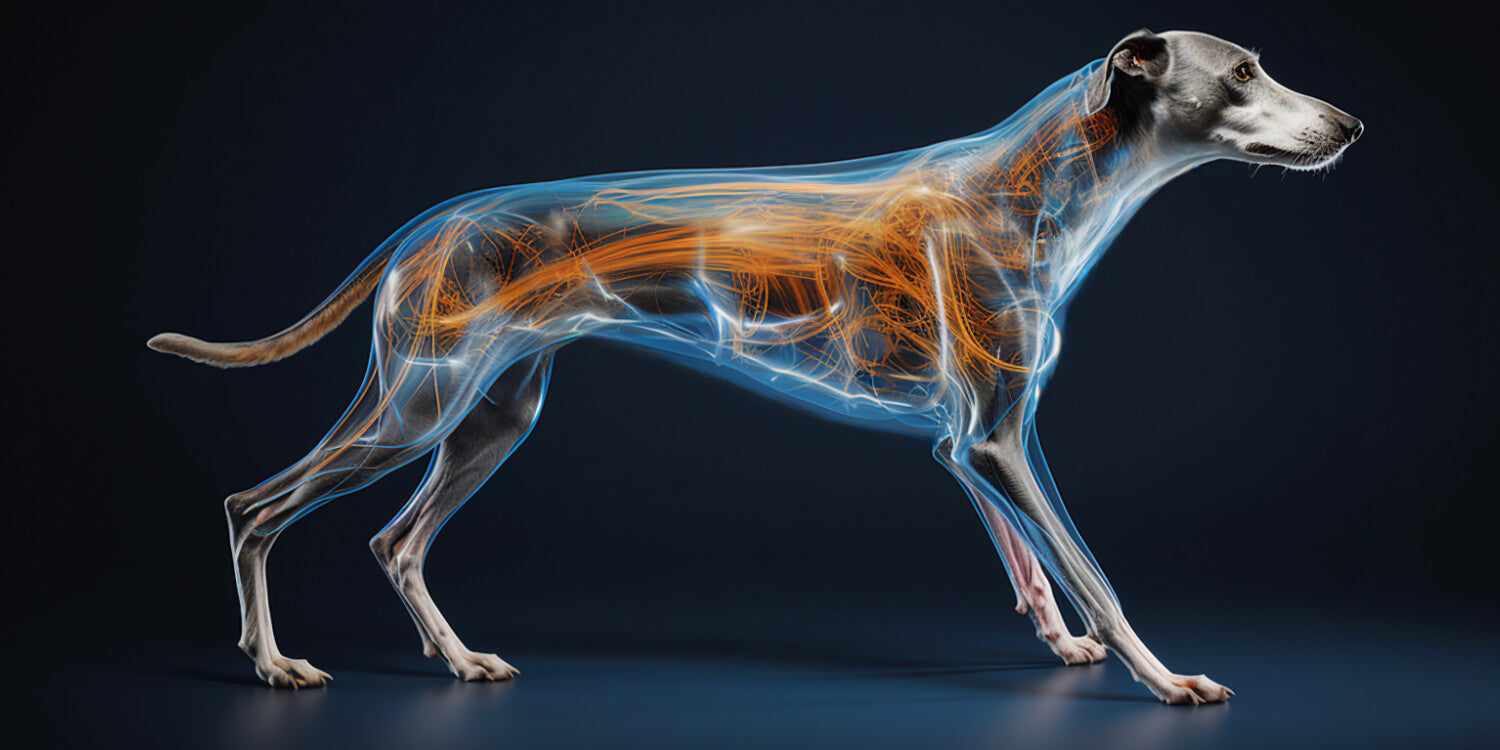The fascinating metabolism of greyhounds revealed: A powerhouse on 4 paws

Overview:
Greyhounds – Their lean body shape and fast metabolism make them exceptional athletes, but they require special care and attention. In this article, we will take an in-depth look at the metabolism of greyhounds and how their lean body shape influences their health and performance. We will examine the specific nutritional and training requirements of this breed, focusing on the role of genetics. We will also address potential health risks and metabolic problems in greyhounds and offer tips for improving their metabolism. To provide a comprehensive overview, we will also present case studies comparing the metabolism of greyhounds with that of other dog breeds. Our goal is to give you, as a greyhound owner or enthusiast, a deeper understanding of the needs and characteristics of this fascinating breed. With in-depth knowledge and proven strategies, you can help ensure your greyhound lives a long, healthy, and happy life. So, let's delve into the fascinating world of greyhound metabolism together.
1. The peculiarities of greyhound metabolism
Greyhounds are known for their lean body shape and ability to reach high speeds. This is due in part to their unique metabolism. Compared to other dog breeds, greyhounds have a higher basal metabolic rate , meaning they burn more calories even when at rest. Additionally, they are able to use their energy more efficiently, which helps them maintain their speed and endurance.
Some of the special features of the greyhound metabolism are:
- Efficient fat burning: Greyhounds are able to burn fat more efficiently than other dog breeds. This allows them to run longer without fatigue.
- Fast recovery: After training or racing, greyhounds recover faster than other dog breeds. This is due to their ability to more efficiently process lactate, a byproduct produced during intense physical activity.
- Solid protein requirements: Due to their high basal metabolic rate, greyhounds require more protein in their diet than other dog breeds. This helps them maintain their muscle mass and improve their performance.
2. Influence of the slim body shape on the metabolism of greyhounds
The slender body shape of greyhounds has a significant impact on their metabolism. Their lean and muscular structure allows them to move at high speeds, which requires high energy expenditure. Therefore, greyhounds have a higher metabolism compared to other dog breeds. This means they burn more calories, even at rest.
To illustrate this, let's look at the following comparison table, which shows the metabolism of greyhounds and other dog breeds:

This table shows that greyhounds burn more calories than other dog breeds. This is due to their lean body shape and active lifestyle . Therefore, greyhounds require a special diet to meet their high energy needs.
3. Nutrition and metabolism: What greyhounds need
 It is essential to understand the specific nutritional needs of greyhounds to ensure their optimal health and performance. Adequate protein content in their diet is crucial as they have a fast metabolism and therefore require more energy. In addition, they need a balanced mix of carbohydrates and fats to maintain their energy levels. Here is a quick checklist for your greyhound's diet: 1. Healthy protein content, 2. Balanced fats and carbohydrates, 3. Adequate hydration, 4. Regular feeding times. It is also important to control portion sizes to avoid excessive weight gain or weight loss. Finally, your greyhound's diet should always be supplemented with regular exercise and adequate rest.
It is essential to understand the specific nutritional needs of greyhounds to ensure their optimal health and performance. Adequate protein content in their diet is crucial as they have a fast metabolism and therefore require more energy. In addition, they need a balanced mix of carbohydrates and fats to maintain their energy levels. Here is a quick checklist for your greyhound's diet: 1. Healthy protein content, 2. Balanced fats and carbohydrates, 3. Adequate hydration, 4. Regular feeding times. It is also important to control portion sizes to avoid excessive weight gain or weight loss. Finally, your greyhound's diet should always be supplemented with regular exercise and adequate rest.4. Training and metabolism: Optimal exercises for greyhounds
Effective training for greyhounds requires careful planning and execution. Their high metabolic rate means they require a constant source of energy to maintain their performance. Therefore, it's important to tailor their diet and training to meet their energy needs while maintaining their athletic, physical disposition.
Choosing the right exercises for greyhounds can make a big difference in their health and performance. Here are some exercises that are particularly well-suited for greyhounds:
- Running: Greyhounds are known for their speed and endurance. Regular running training helps them strengthen their muscles and improve their endurance.
- Swimming: This is an excellent exercise for greyhounds as it uses the whole body while being gentle on the joints.
- Agility training: This training improves dogs' dexterity and coordination and is a great way to promote their mental and physical fitness.
It's important to tailor training to your dog's individual needs, abilities, and health status. The intensity and duration of training should be increased gradually to avoid overexertion and injury. Remember that a balanced diet and adequate rest are just as important as the training itself to ensure your greyhound's health and well-being.
5. Health risks and metabolic problems in greyhounds
Despite their impressive speed and endurance, greyhounds are prone to certain health risks and metabolic problems . Their lean body type and low body fat make them sensitive to extreme temperatures and require a specialized diet to meet their high energy needs. Additionally, their genetic predisposition can predispose them to certain diseases, including osteosarcoma, a form of bone cancer, and greyhound polyneuropathy, a rare neurological disorder.
Another problem that can occur in greyhounds is a metabolic disorder called hypothyroidism . This condition, caused by a lack of thyroid hormones, can lead to a variety of symptoms, including weight gain, hair loss, skin problems, and lethargy. Although hypothyroidism is less common in greyhounds than in other breeds, it's important to watch for signs of this condition and seek treatment if necessary.
When it comes to preventing health risks and metabolic problems in greyhounds, a balanced diet is crucial. A balanced diet full of high-quality, healthy proteins and nutritious, rich fats can effectively support their metabolism and promote their overall robust health. Furthermore, it's important to schedule regular veterinary visits whenever any abnormalities arise to detect and treat potential health problems early. In conclusion, despite the potential health risks and metabolic problems, greyhounds are a very robust and healthy breed. Greyhounds are more resilient than many people assume.
6. The role of genetics in greyhound metabolism

Research has shown that genetics plays a crucial role in the metabolism of greyhounds. Their unique genetic predisposition allows them to use energy efficiently and run fast. This ability is the result of generations of natural and evolutionary selection aimed at speed and endurance for survival. Furthermore, genetics also influences the lean body shape of these dogs. They tend to have less body fat and more muscle mass compared to other dog breeds. This contributes to their ability to reach high speeds and cover long distances. In summary , genetics has a significant impact on the metabolism and body shape of greyhounds, explaining their remarkable abilities for high performance.
7. Metabolism Booster: Tips for Improving Greyhound Metabolism

Improving a greyhound's metabolism requires careful consideration and planning. Diet plays a crucial role and should be rich in wholesome proteins and, not to mention, healthy fats to meet energy needs and support metabolism. Regular exercise is also important to stimulate metabolism and promote overall health. In addition, supplementing with certain nutrients , such as omega-3 fatty acids and antioxidants, can help optimize metabolism and improve your greyhound's health. In conclusion, a balanced diet and regular exercise in nature are the keys to improving your greyhound's metabolism.
8. Case studies: Metabolism of greyhounds compared to other dog breeds
In the context of veterinary medicine and animal nutrition , the metabolism of greyhounds plays a notable role . This particular breed of dog has a unique metabolism that distinguishes it from other dog breeds. Greyhounds have a higher metabolism, related to their lean body shape and their need for intense physical activity. This high metabolism allows them to process food more efficiently and burn energy faster than other dog breeds.
The metabolic rate of greyhounds also affects their nutritional needs. Compared to other dog breeds, greyhounds require a diet rich in protein, fat, and calories to meet their energy needs. Additionally, due to their fast metabolism, they occasionally require more frequent meals.

















Leave a comment